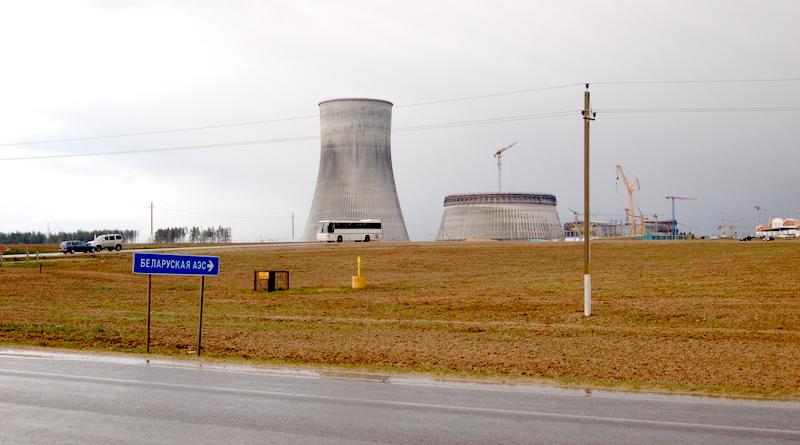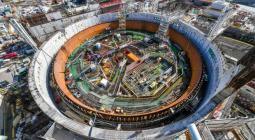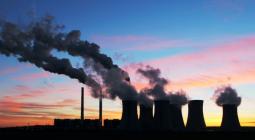In the heat of political crisis, Belarus launches first nuclear power plant.

Ecologists do not share the government's optimism about Astravets.
pid changes is that Belarus’ first nuclear power plant is located outside the town. Its construction is now coming to an end and it is nearly ready to be started up. As engineers often explain, it takes more than pressing one button to launch a nuclear reactor.
That start-up will take place in several phases. The fuel has already been loaded; the plant is expected to generate its first electricity on November 7. This is a national holiday in Belarus, as it is the anniversary of the October Revolution — the revolution from which the Soviet Union was born.
“I invite everybody. I think that on November 7, a significant day for us, we will be able to visit and say that we have received the first electricity from our own nuclear power plant”, exclaimed Belarus’ longtime ruler Alyaksandr Lukashenka at a meeting with officials on September 16. The first of the two reactors is expected to operate at full capacity by the first quarter of 2021. The second reactor will be launched in 2022.
Haunting memories
But not all Belarusians are so jubilant. They remember the explosion in 1986, which released large amounts of radiation into the atmosphere. Belarus suffered more than anywhere else in the Soviet Union; a third of all the radioactive caesium-137 ended up in Belarusian territory. The authorities in Minsk have tried to assuage fears of a second Chernobyl, declaring that the likelihood of accidents is minimal, and that the Astravets nuclear power plant is a safe and profitable project.
“We are the Chernobyl republic, we have experienced a lot and we know the consequences ourselves. Some US$19 billion has been spent on rehabilitating contaminated areas alone. Therefore, safety measures during the construction of the [Astravets] power station were like something out of wartime”, said Lukashenka in August, just before the presidential elections.
In the public discussion about nuclear energy, comparisons between Chernobyl and Astravets are not so uncommon. These parallels are drawn by everybody, including journalists, politicians, ordinary citizens, and surviving liquidators from the Chernobyl catastrophe. They all deeply regret what occurred in 1986, but their opinions on 2020 strongly differ. Some strongly support the new nuclear power plant and hope for an increased standard of living, while others fear another accident.
Belarusian state media and officials do not shirk from mentioning Chernobyl, either.
“The memory of the events at Chernobyl is now being instrumentalised and used to legitimise the new nuclear power plant. On the 30th anniversary of the accident, a documentary film was broadcast which began with footage of the 1986 accident and ended with a hint that this time, everything would be alright,” writes Alexey Bratochkin, head of public history projects at the European College of Liberal Arts in the Belarusian capital of Minsk.
Once the nuclear power plant is fully operational, explained the authorities in the early stages of construction, electricity prices will fall. In 2014, the Ministry of Energy promised that electricity “will become cheaper for the consumer” by 20-30 percent.
But some Belarusians seem to be sceptical about promises of cheap energy. They also doubt that the power plant will open at all, given that its launch has already been postponed at least four times. All these views can be seen in local community groups on social media:
“I work on the construction site of the nuclear power plant, and [acquaintances] sometimes ask me when it will be launched. I think [the plant’s management] don’t even know themselves, they say within two to three years at a minimum”, says Alyaksandr, who was born and grew up in Astravets, in a Telegram chat with GlobalVoices.
Does Alyaksandr expect a drop in electricity prices? He might be right to, given that electric vehicles are already under development and power engineers are modernising heating networks in newly-constructed residential buildings to be more energy efficient.
“Logically that should be the case. But in Volgodonsk [a city in Russia] there’s also a nuclear power plant. There are more than two reactors, but after the plant was constructed energy actually became more expensive”, remarks Alyaksandr.
He may be right, according to the results of a study conducted by the Belarusian NGO EcoDom this summer. The authors concluded that the electricity prices for Belarusian consumers will almost double in price.
“The prime cost of electricity in the network as a whole will not decrease, but will increase from four cents to [US$]7.26; that is, 1.8 times”, concluded EcoHome.
A geopolitical gambit
There have also been geopolitical promises. Namely, that Belarus would lessen its energy dependence on natural gas supplies from Russia. Nuclear power is “part of our independence”, and its greater use would ensure “sovereignty and independence”, promised Lukashenka in September.
Indeed, shortly before the decision to construct Astravets was taken in 2007, Russia accounted for some 85 percent of all Belarus’ energy imports. Much of this is natural gas, from which Belarus generates 93 percent of its electricity.
In their quest to reduce their country’s energy dependence on Russia, the Belarusian authorities turned to an old partner — Russia. Moscow was happy to oblige, offering a loan of up to $10 billion for the new power plant. This loan must be repaid over a 15 year period, starting from 2023. Thus the Belarusian leadership tied itself to a massive financial obligation to the same country from which it wanted to reduce dependence.
“The political meaning of the construction and launch of the nuclear power plant was associated with the goal of ensuring energy security for Belarus. It probably isn’t the best idea. The nuclear power plant is an ongoing economic and political miscalculation”, says Andrey Yegorov, a political scientist and analyst at the Centre for European Transformation and member of the board of the Green Network, a partnership of environmental organisations. In an interview with GlobalVoices, Yegorov emphasised that now Belarus will not only pay loans to Russia, it will still need to buy Russian energy resources. Only now it will import nuclear fuel.
Astravets could certainly cover much of Belarus’ domestic energy needs — in fact, according to the Ministry of Energy, the plant is likely to generate a surplus. All that excess energy must go somewhere, but where?
Russia is well supplied by its own nuclear power plants. Belarus’ other neighbours do not intend to buy energy from Astravets, which they consider unsafe.
Lithuania is a particularly fierce opponent both of the construction of the power plant and purchasing energy it will generate. After all, Astravets lies just 20 kilometres from its border. Vilnius has even passed a law on boycotting electricity from the new power plant.
On October 26, Litgrid, operator of Lithuania’s national electricity grid, announced how it would react to the first receipt of electricity from Belarus, which is expected between November 1-10. “We will immediately set the capacity to zero megawatts for all commercial electricity flows from Belarus”, said Litgrid’s interim head Vidmantas Grušas in a press release.
This statement is the consequence of Lithuania’s long-standing position. It was summed up by President Ginatas Nausėda on October 21.
“The Belarusian nuclear power plant poses a threat to the safety of EU citizens. Therefore it is necessary to put a stop to the irresponsible launch of this nuclear power plant”, said Nausėda.
Estonia, Latvia, and Poland have all announced their refusal to purchase energy from Astravets, partly out of solidarity with Lithuania’s position. Ukraine has also declined, stating that it has its own energy surplus.
At a meeting of the Council of Europe in October, European leaders stressed that the degree of compliance with and implementation of safety requirements and tests at the Astravets nuclear power plant would affect relations between the EU and Belarus.
The ecologists’ revolt
In September, the Belarusian Green Party and several ecological organisations released a declaration against the nuclear power plant at Astravets. As they saw it, its launch was even more dangerous in the context of a political crisis.
“Let’s start with the fact that the internal troops and security forces, which could be involved in mitigating the consequences of any crisis, are now busy with something else entirely — clashing with protesters”, write the ecologists.
Indeed, police detain an average of 500-700 people every weekend during protests. And protests don’t just take place on weekends. Judging by the estimates of the Belarusian human rights centre Viasna, more than 16,000 people have been detained since August 9. As of early October, human rights defenders had recorded over 2,000 complaints of torture and violence during detention, according to the International Committee on the Investigation of Torture.
Meanwhile, layoffs and strikes are also taking place. For example, on October 26 some factory workers, including those at chemical plants, did not turn up at work. On the same day, Alyaksandr Lukashenka’s Telegram channel noted that “the president, like all right-minded Belarusians, is at work today”.
Yegorov, the political scientist, notes that in the current situation, being right-minded means sensibly assessing the risks:
“A nuclear power plant can be highly dangerous and is very risky to operate. Putting one into operation amid unprecedented epidemiological, political and economic crises is risky”, he says.
It must be added that at the time of writing, the COVID-19 infection rate in Belarus has peaked. It now stands where it did in May, during the first wave of the pandemic.
“First and foremost, the danger posed by the nuclear power plant is not connected with the political system nor the epidemiological situation”, remarks Andrey Ozharovsky, an active participant of the Belarusian anti-nuclear movement.
Ozharovsky believes that nuclear power is dangerous in any situation; Chernobyl exploded under socialism and Fukushima under capitalism. Nevertheless, the danger may increase if the launch itself becomes a political event:
“Belarus’ atomic project has been a political one from the outset, as Lukashenka has said many times. If it is in his personal interests to rush its start-up, then in accordance with old Soviet traditions, the facility may be commissioned with imperfections. When it comes to a nuclear power plant, that dramatically increases the likelihood of severe accidents”, warns Ozharovsky.
The long term future of the facility at Astravets also poses a key problem: the power plant will function for 60 years, but radioactive waste remains dangerous for several thousand. However, political realities can be far more fleeting.
“If the ruling powers in Belarus change, the question will arise as to whether Belarus needs this nuclear power plant. Let me remind you that countries such as Germany have rejected nuclear energy. France has made it a political goal to reduce its independence on nuclear energy from 70 to 50 percent”, Ozharovsky explains.
Waiting for the green revolution
In the short term, ecologists see Astravets as a setback for Belarusian renewable energy.
According to a 2018 study by EcoHome and the Institute for Technical Thermodynamics of the German Aerospace Centre, Belarus could close its nuclear power plant by 2040 and fully transition to renewable energy by 2050.
Pavel Gorbunov, an energy researcher with EcoHome, calls the Astravets nuclear power plant an unprofitable project. He is convinced that it would be cheaper not to launch the plant, recognising the investment as a loss maker and starting to pay back the loan which Belarus took out for its construction.
“In the medium and the long term, the Astravets nuclear power plant will compete with prices for electricity from renewable sources”, said Gorbunov in an interview.
This is because Belarus is currently developing renewable energy alongside its nuclear sector. However, the launch of the new power plant and the surplus of electricity which it will produce are expected to reduce investor interest in developing industrial-scale renewable energy. This is the belief of Vladimir Nistyuk, the executive director of Belarus’ Renewable Energy Association, which includes about 40 organisations.
The launch also threatens to reduce the opportunities for producers of energy from renewable sources to sell their electricity back to the national grid. It will also impact the “elimination of increasing coefficients”, which allowed them to do so at a more favourable price.
At the same time, the expert notes that there remains a public interest in energy sources which allow ordinary people and companies alike to generate their own electricity. Biogas is being actively developed, he adds.
“In general, even if the development of renewable [energy] sources slows down, it will not be for long. As Karl Marx said, one cannot live in society and be free from it”, Nistyuk told GlobalVoices.
“There’s no getting away from that, because we live in a civilised world which has long since started to appreciate the benefits of renewable energy and its prospects. We are optimists”.
29 October 2020
Global Voices




